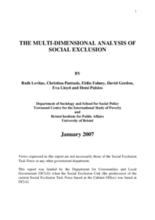This project reviews existing sources on multi-dimensional disadvantage or severe forms of social exclusion characterised as ‘deep exclusion’ for the purpose of recommending possibilities for secondary analysis of existing data sets to explore the dynamics of ‘deep exclusion’. It also identifies any relevant gaps in the knowledge base; and to recommend research strategies for filling such gaps.
The project notes that it is not clear as to whether or not deep exclusion can be separated from social exclusion; however, there is overwhelming evidence that poverty is a major risk factor in almost all domains of exclusion that have been explored.
The project developed the Bristol Social Exclusion Matrix for this study. The matrix consisted of ten dimensions that evaluated people’s resources, participation, and quality of life. It evaluated people along four stages of life: childhood, youth, working adult age, and later life.
After evaluation, the team came up with the following recommendations:
1. Secondary analysis using B-SEM to identify appropriate domains and indicators of the surveys listed above.
2. The PSE Survey has the most extensive coverage of social exclusion. Repeat an improved version of the PSE Survey with a larger sample size and an ethnic booster. If possible recontact the households in the original survey to provide a longitudinal element.
3. Generate a ‘Social Exclusion Module’ based on the B-SEM for inclusion in the future UKLHS (or in the BHPS or GHS).
4. Undertake qualitative research work using in-depth interviews and life history technique with those groups at particular risk of social exclusion.
5. Use the findings from this qualitative work when possible to inform specialised surveys of social exclusion among the non-household population.

